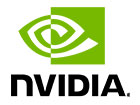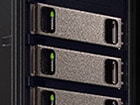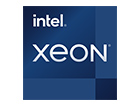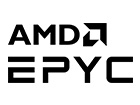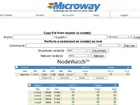Benchmark Your Application
The best performance comparison will always be benchmark testing of the application(s) that will run on your computer. You can check with your software vendor to determine if they have a list of such benchmarks results. In our experience, most software vendors don’t have the resources to maintain such lists (or they are several years out of date).
If you’re willing, you may contact one of Microway’s technical experts to request a Test Drive. We can provide a remote log-in to one of our systems to demonstrate the performance increase. Certain scientific applications are pre-installed, so get in touch!
Alternatives to Benchmarking
If no benchmarks are published for your application(s), it’s still possible to find results tailored to your field. Read through the list of applications and problem descriptions below. If any are similar to your application, contact a Microway representative to learn what speedups you should expect.
One of our representatives can also give you rough guidelines on the factors that have changed between the generation of hardware you’re currently using and the latest generation. For example, Intel Xeon CPUs released before 2012 typically completed four floating-point operations per clock cycle. With the release of CPUs supporting AVX, this increased to eight floating-point operations per cycle.
Industry-Standard CPU Performance Benchmarks – SPEC CPU2006
SPEC CPU2006 Benchmarks (Floating Point)
| Application Area | Benchmark | Brief Description |
|---|---|---|
| CFD | LESlie3d | Large-Eddy Simulations with Linear-Eddy Model in 3D. Supports turbulence phenomena such as mixing, combustion, acoustics and general fluid mechanics. For SPEC, solve a subset of such flows, namely the temporal mixing layer. This type of flow occurs in the mixing regions of all combustors that employ fuel injection (which is nearly all combustors). |
| CFD | bwaves | Simulates blast waves in 3D transonic transient laminar viscous flow. |
| CFD | LBM | Implements the “Lattice-Boltzmann Method” to simulate incompressible fluids in 3D (computationally the most important part of a larger code which is used in the field of material science to simulate the behavior of fluids with free surfaces, in particular the formation and movement of gas bubbles in metal foams). |
| Computational Electromagnetics | GemsFDTD | Solves the Maxwell equations in 3D using the finite-difference time-domain (FDTD) method. For SPEC, the radar cross section (RCS) of a perfectly conducting (PEC) object is computed. |
| FEA | CalculiX | Finite element code for linear and nonlinear 3D structural applications. Uses the SPOOLES solver library to solve CrunchiX. |
| FEA | deal II | Program library targeted at adaptive finite elements and error estimation. For SPEC, solves a Helmholtz-type equation with non-constant coefficients in 3D (used for incompressible fluid flow, static or time-harmonic electromagnetics, static and quasi-static elasto-plasticity, general relativity, and implicit time stepping schemes for seismic, acoustic, and electromagnetic applications). |
| Image Ray-tracing | POVRAY | For SPEC, render a 1280×1024 anti-aliased image of a chessboard and abstract objects; all object surfaces are procedurally textured (e.g., Perlin noise function). |
| Linear Programming, Optimization | SoPlex | Solves a linear program using a simplex algorithm and sparse linear algebra. Test cases include railroad planning and military airlift models. |
| Molecular Dynamics | GROMACS | Simulates the Newtonian equations of motion for systems with hundreds to millions of particles. For SPEC, performs a simulation of the protein Lysozyme in a solution of water and ions (23,179 atoms). |
| Molecular Dynamics | NAMD | Simulates large biomolecular systems. For SPEC, simulates apolipoprotein A-I (92,224 atoms). |
| Quantum Chemistry | GAMESS | Supports a wide range of quantum chemical computations. For SPEC, self-consistent field (SCF) calculations are performed using the Restricted Hartree Fock method, Restricted open-shell Hartree-Fock, and Multi-Configuration SCF. |
| Quantum Chemistry | Tonto | Open source quantum chemistry package. The test case places a constraint on a molecular Hartree-Fock wavefunction calculation to better match experimental X-ray diffraction data. |
| Quantum Chromodynamics | MILC | A gauge field generating program for lattice gauge theory programs with dynamical quarks. For SPEC, the serial version of su3imp is used. |
| Physics / CFD | ZEUS-MP | A CFD code developed for the simulation of astrophysical phenomena (ideal, non-relativistic, hydrodynamics and magnetohydrodynamics, including externally applied gravitational fields and self-gravity). For SPEC, simulates a 3D blastwave with the presence of a uniform magnetic field along the x-direction. |
| Physics / General Relativity | CactusADM | Solves the Einstein evolution equations, which describe how spacetime curves as response to its matter content (a set of ten coupled nonlinear partial differential equations). A staggered-leapfrog numerical method is used to carry out the update. |
| Speech Recognition | Sphinx-3 | A widely-known speech recognition system from Carnegie Mellon University. |
| Weather | WRF | next-generation mesocale numerical weather prediction system from scales of meters to thousands of kilometers. For SPEC, simulate a 30km area over 2 days. |
Official SPEC CPU2006 Benchmarks (Floating Point) descriptions
SPEC CPU2006 Benchmarks (Integer)
| Application Area | Benchmark | Brief Description |
|---|---|---|
| Artificial Intelligence | Sjeng | A highly-ranked chess program that also plays several chess variants. It attempts to find the best move via a combination of alpha-beta or priority proof number tree searches, advanced move ordering, positional evaluation and heuristic forward pruning. |
| Artificial Intelligence | gobmk | Plays the game of Go, a simply described but deeply complex game. The program plays Go and executes a set of commands to analyze Go positions. |
| C Compiler | gcc | Based on gcc Version 3.2 – generates code for an AMD Opteron processor. |
| Combinatorial Optimization | MCF | Vehicle scheduling. Uses a network simplex algorithm (which is also used in commercial products) to schedule public transport. |
| Compression | bzip2 | Julian Seward’s bzip2 version 1.0.3, modified to do most work in memory, rather than doing I/O. |
| Discrete Event Simulation | OMNeT++ | Uses the OMNet++ discrete event simulator to model a large Ethernet campus network (about 8000 computers and 900 switches/hubs). |
| Gene Sequence Search | HMMER | Protein sequence analysis using profile hidden Markov models (profile HMMs). Used in computational biology to search for patterns in DNA sequences. |
| Path-finding | A-star | Pathfinding library for 2D maps, including the well known A* algorithm. |
| Physics / Quantum Computing | libquantum | Simulates a quantum computer, running Shor’s polynomial-time factorization algorithm. |
| Programming Language | perlbench | Derived from Perl V5.8.7. The workload includes SpamAssassin, MHonArc (an email indexer), and specdiff (SPEC’s tool that checks benchmark outputs). |
| Video Compression | H264ref | A reference implementation of H.264/AVC – encodes a videostream using 2 parameter sets. The H.264/AVC standard has largely replaced the older MPEG2 standard. |
| XML Processing | Xalan-C++ | Transforms XML documents to other document types (100 MB test data). |

